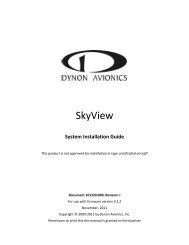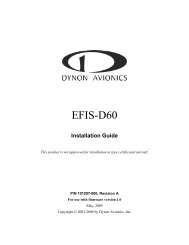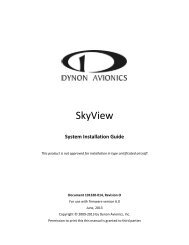EFIS-D100 Installation Guide - Dynon Avionics
EFIS-D100 Installation Guide - Dynon Avionics
EFIS-D100 Installation Guide - Dynon Avionics
Create successful ePaper yourself
Turn your PDF publications into a flip-book with our unique Google optimized e-Paper software.
Appendix<br />
Appendix D: <strong>Dynon</strong> AOA/Pitot <strong>Installation</strong> and Calibration<br />
Thank you for your purchase of <strong>Dynon</strong>’s AOA/Pitot Probe. This guide walks you through the<br />
steps to install and calibrate both the heated and unheated versions of the AOA/Pitot Probe.<br />
While the probe senses standard pitot pressure, allowing it to work with any standard airspeed<br />
indicator, its AOA functionality is designed specifically to work with <strong>Dynon</strong>’s <strong>EFIS</strong> series of<br />
products. Do not expect it to work properly with another AOA system.<br />
To ensure accuracy, it is very important that you install the probe correctly and perform the<br />
specified calibration steps. We recommend that you read the entire guide before proceeding with<br />
the installation.<br />
Dyn on’ s Heated AOA/Pitot Probe is nickel-plated. Do not polish the probe as this will cause the<br />
finish to come off.<br />
AOA CALCULATION: PRINCIPLES OF OPERATION<br />
Dyn on <strong>Avionics</strong>’ AOA/Pitot probe performs two functions: airspeed sensing and angle of attack<br />
sensin g. These functions require two pressure ports on the tip of the probe. The normal pitot<br />
pressure port is on the front face of the probe and is designed to be insensitive to angle of attack.<br />
The second pressure port is located on an angled surface just under the pitot port and is designed<br />
to be very sensitive to AOA. The <strong>EFIS</strong>-<strong>D100</strong> then uses the difference between these two<br />
pressures to calculate the current angle of attack.<br />
HEATING: PRINCIPLES OF OPERATION<br />
The heated version of <strong>Dynon</strong>’s AOA/Pitot Probe utilizes a heating mechanism unlike any other<br />
heated pitot on the market. The probe is heated by a high-quality nichrome heating element<br />
whose temperature is accurately measured and regulated by the heater controller. This controller<br />
– located in an enclosure which can be mounted in a wing or elsewhere – regulates the heat at the<br />
tip of the probe to a constant temperature. There are several advantages to this, including: lower<br />
power consumption, increased heating element lifespan, and a much cooler pitot on the ground<br />
when de-icing is not necessary. This unique technique ensures that the pitot can be rapidly deiced<br />
when required, but does not needlessly waste electricity when not in icing conditions.<br />
While the probe does not operate like a normal heated pitot, it will still get fairly hot in normal<br />
ambient temperatures. When turned on, it will regulate its internal temperature to about 70°C to<br />
80°C. To ensure that the heater is working, briefly touch the end of the pitot farthest from the<br />
snout after 1 minute of operation and verify that it is warm.<br />
FAILURE WARNING<br />
Designed to meet the indication requirements of FAR 23.1326, the heated pitot controller has an<br />
output that can trigger a warning light in the cockpit whenever the probe heater is turned off or is<br />
not functioning properly. While not required for Experimental and LSA category aircraft, this<br />
feature provides peace of mind, giving you instant feedback that your probe’s heater is working<br />
as designed.<br />
7-24 <strong>EFIS</strong>-<strong>D100</strong> <strong>Installation</strong> <strong>Guide</strong>
















